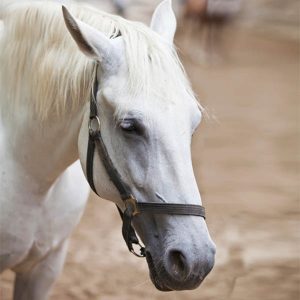
Equine Gastric Ulcers—Do You Need To Worry?
A scoop of grain and two fluffy flakes of hay in the morning. A scoop of grain and two fluffy flakes of hay in the late afternoon. A few hours of turnout on mediocre pasture sometime during the day. Sound familiar?
This feeding pattern is repeated almost without thought, but is it best for a horse? Does it sufficiently mimic a horse’s natural desire to graze, and does it keep a horse’s gastrointestinal tract in tip-top shape? Or is a horse unwittingly being set up for development of gastric ulcers?
Researchers specializing in equine nutrition think not. They believe that horses with the healthiest stomachs are given free access to forage, whether they spend their days mowing down pasture grass or confined to a shed or run munching on hay. While good-quality forage is the foundation of any diet intended for horses, it’s not just the forage that prevents gastric ulceration.
In truth, the constant exposure of the stomach to saliva also aids in preventing gastric ulcers. Saliva is instrumental in keeping the stomach healthy. Once feed is thoroughly ground and coated with saliva, the bolus of chewed feed can pass easily from the oral cavity to the stomach. In the stomach, saliva takes on a new role, that of a buffering agent that neutralizes acids normally found in the stomach. The combined effects of saliva and a feeding regimen that includes constant access to forage leave the horse well protected against gastric ulcers.
What if a horse does not have forage available at all times? The risk of gastric ulcers increases tremendously. When the stomach is left empty for long periods, gastric acid begins to erode the organ’s sensitive lining, causing the development of the painful lesions. If a horse is fed in “meals,” as the scenario above suggests, with little access to forage otherwise, the presence of ulcers is almost assured.
Occasionally, horses that are allowed access to forage at all times are diagnosed with gastric ulcers. In these instances, researchers believe that stress may be involved in their development. A thorough evaluation of the horse’s management must be reviewed, and potential stressors should be eliminated from his routine.
A horse with gastric ulcers may express a noticeable change in disposition, likely stemming from discomfort. He may become grouchy with a tendency to pin his ears or swish his tail, and show decreased performance punctuated by an unwillingness to work. From a physical standpoint, a horse may lose weight and his coat may lose its shine.
If ulcers are suspected, a veterinarian can perform a procedure known as gastric endoscopy. This procedure involves snaking a flexible tube, complete with tiny camera, through the oral cavity, down the esophagus, and into the stomach. The apparatus is outfitted with a bright light so the veterinarian is able to evaluate the condition of the tissues as it is passed. A definitive diagnosis can be made using this procedure. If found, ulcers can be healed with a medication called omeprazole, which is available through veterinarians.
According to Benjamin Franklin, “An ounce of prevention is worth a pound of cure,” so to support healthy gastric pH levels and protect sensitive mucosal tissues from irritation in at-risk horses, or those who have suffered from ulcers in the past, include a supplement that supplies buffering and coating agents such as Neigh-Lox Advanced.



1 Comment
I found it really interesting that feeding meals makes the horse more prone to ulcers and yet that is how we most commonly feed our horses and then just give them treatments like ulcer guard.